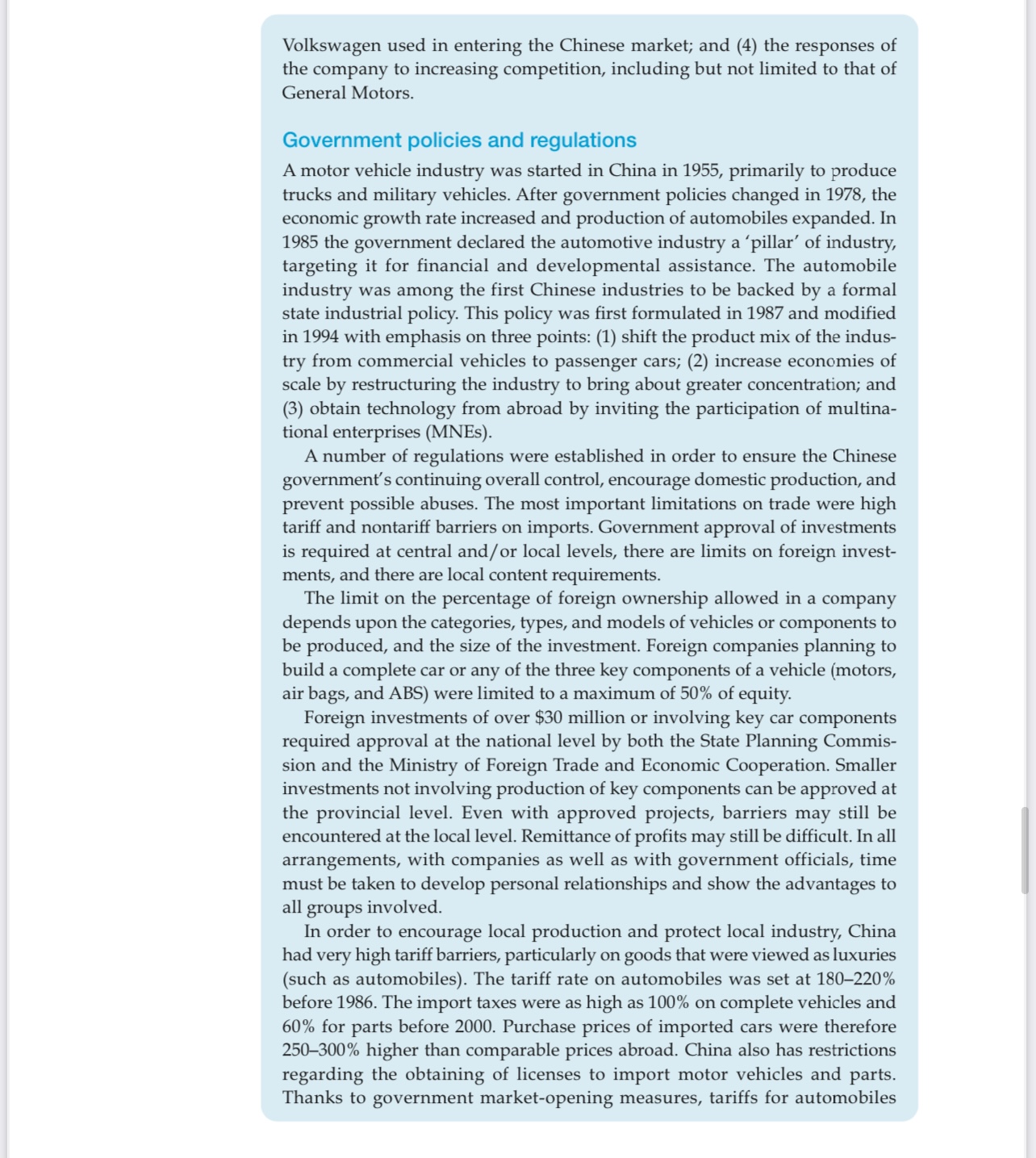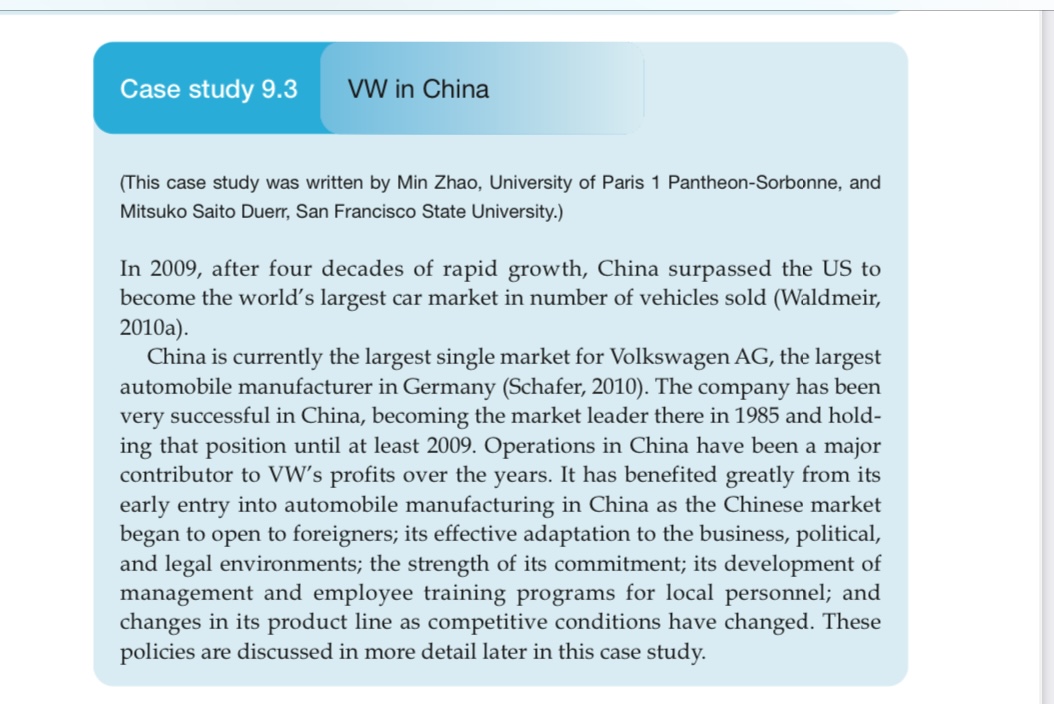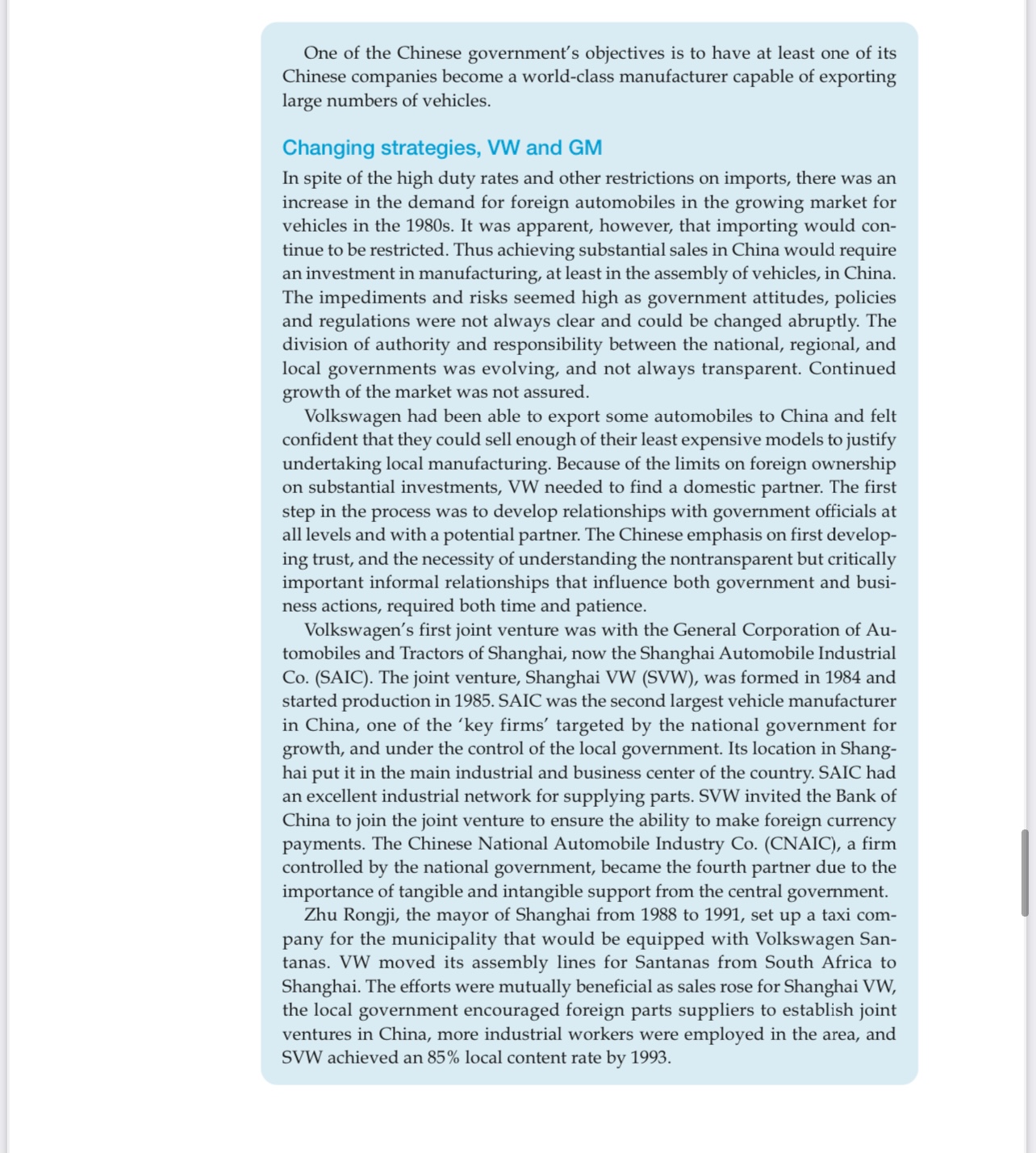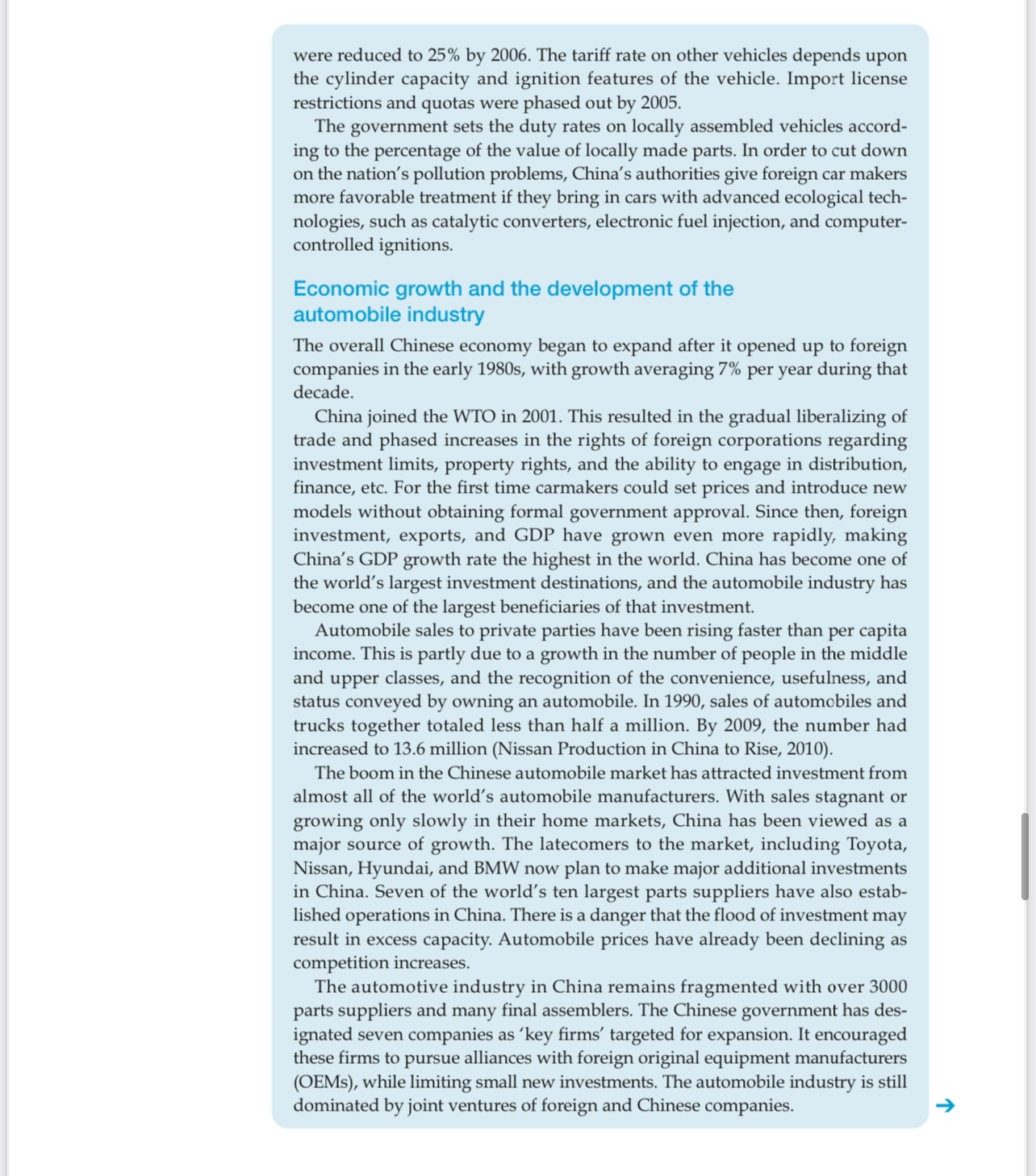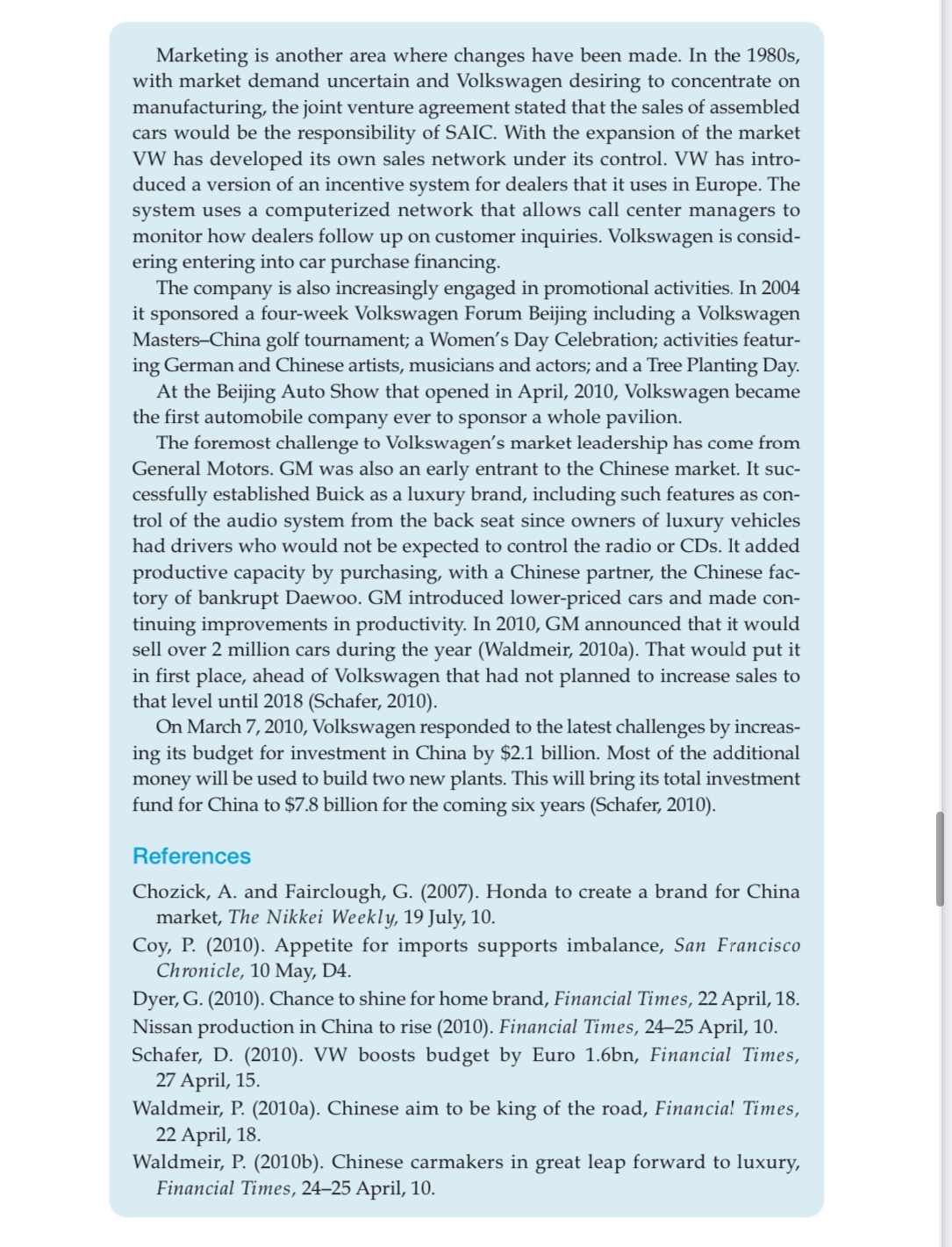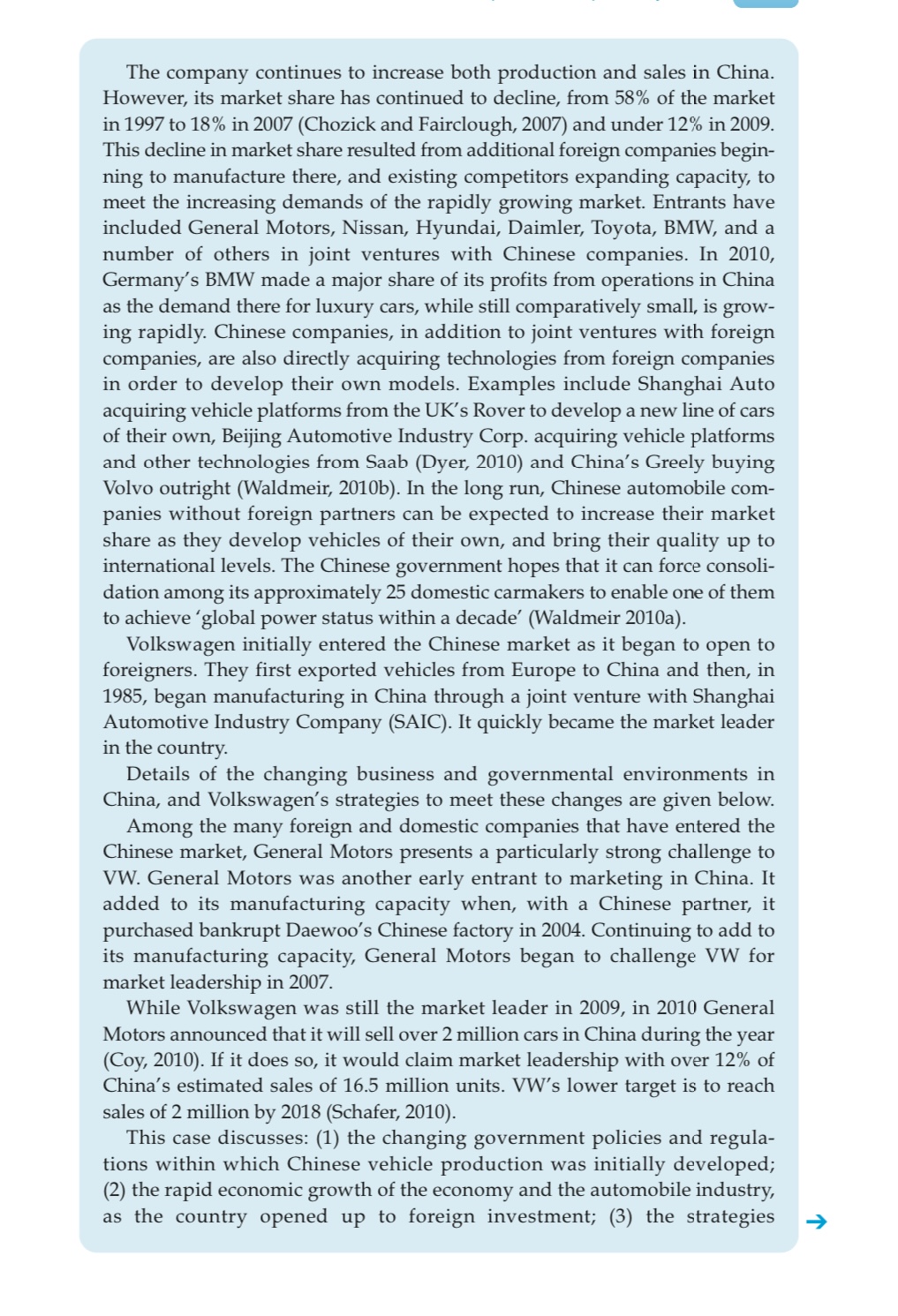Volkswagen used in entering the Chinese market; and (4) the responses of the company to increasing competition, including but not limited to that of General Motors. Government policies and regulations A motor vehicle industry was started in China in 1955, primarily to produce trucks and military vehicles. After government policies changed in 1978, the economic growth rate increased and production of automobiles expanded. In 1985 the government declared the automotive industry a 'pillar' of industry, targeting it for nancial and developmental assistance. The automobile industry was among the first Chinese industries to be backed by a formal state industrial policy. This policy was first formulated in 1987 and modied in 1994 with emphasis on three points: (1) shift the product mix of the indus- try from commercial vehicles to passenger cars; (2) increase economies of scale by restructuring the industry to bring about greater concentration; and (3) obtain technology from abroad by inviting the participation of multina- tional enterprises (MNEs). A number of regulations were established in order to ensure the Chinese government' 5 continuing overall control, encourage domestic production, and prevent possible abuses. The most important limitations on trade were high tariff and nontariff barriers on imports. Government approval of investments is required at central and I or local levels, there are limits on foreign invest- ments. and there are local content requirements. The limit on the percentage of foreign ownership allowed in a company depends upon the categories, types, and models of vehicles or components to be produced, and the size of the investment. Foreign companies planning to build a complete car or any of the three key components of a vehicle (motors, air bags, and ABS) were limited to a maximum of 50% of equity. Foreign investments of over $30 million or involving key car components required approval at the national level by both the State Planning Commis- sion and the Ministry of Foreign Trade and Economic Cooperation Smaller investments not involving production of key components can be approved at the provincial level. Even with approved projects, barriers may still be encountered at the local level. Remittance of prots may still be difficult. In all arrangements, with companies as well as with government officials, time must be taken to develop personal relationships and show the advantages to all groups involved. In order to encourage local production and protect local industry, China had very high tariff barriers, particularly on goods that were viewed as luxuries (such as automobiles). The tariff rate on automobiles was set at ISO220% before 1986. The import taxes were as high as 100% on complete vehicles and 60% for parts before 2000. Purchase prices of imported cars were therefore 250-30096 higher than comparable prices abroad. China also has restrictions regarding the obtaining of licenses to import motor vehicles and parts. Thanks to government market-opening measures, tariffs for automobiles Case study 9.3 {This case study was written by Min Zhao, University of Paris 1 Parrthaon-Sorbonne, and Mltsuko Saito Duen; San Francisco State University.) In 2009, after four decades of rapid growth, China surpassed the US to become the world's largest car market in number of vehicles sold (Waldmeir, 2010a). China is currently the largest single market for Volkswagen AG, the largest automobile manufacturer in Germany (Schafer, 2010). The company has been very successful in China, becoming the market leader there in 1935 and hold- ing that position until at least 2009. Operations in China have been a major contributor to VW's profits over the years. It has benefited greatly from its early entry into automobile manufacturing in China as the Chinese market began to open to foreigners; its effective adaptation to the business, political, and legal environments; the strength of its commitment; its development of management and employee training programs for local personnel; and changes in its product line as competitive conditions have changed. These policies are discussed in more detail later in this case study. One of the Chinese govemment' s objectives is to have at least one of its Chinese companies become a world-class manufacturer capable of exporting large numbers of vehicles. Changing strategies, VW and GM In spite of the high duty rates and other restrictions on imports, there was an increase in the demand for foreign automobiles in the growing market for vehicles in the 19805. It was apparent, however, that importing would con- tinue to be restricted. Thus achieving substantial sales in China would require an investment in manufacturing, at least in the assembly of vehicles, in China. The impediments and risks seemed high as government attitudes, policies and regulations were not always clear and could be changed abruptly. The division of authority and responsibility between the national, regional, and local governments was evolving, and not always transparent. Continued growth of the market was not assured. Volkswagen had been able to export some automobiles to China and felt confident that they could sell enough of their least expensive models to justify undertaking local manufacturing. Because of the limits on foreign ownership on substantial investments, VW needed to find a domestic partner. The first step in the process was to develop relationships with government officials at all levels and with a potential partner. The Chinese emphasis on first develop- ing trust, and the necessity of understanding the nontransparent but critically important informal relationships that influence both government and busi- ness actions, required both time and patience. Volkswagen's first joint venture was with the General Corporation of Au- tomobiles and Tractors of Shanghai, now the Shanghai Automobile Industrial Co. (SAIC). The joint venture, Shanghai VW (SVVV), was formed in 1984 and started production in 1985. SAIC was the second largest vehicle manufacturer in China, one of the 'key firms' targeted by the national government for growth, and under the control of the local government. Its location in Shang- hai put it in the main industrial and business center of the country. SAIC had an excellent industrial network for supplying parts. SVW invited the Bank of China to join the joint venture to ensure the ability to make foreign currency payments. The Chinese National Automobile Industry Co. (CNAIC), a firm controlled by the national government, became the fourth partner due to the importance of tangible and intangible support from the central government. Zhu Rongji, the mayor of Shanghai from 1938 to 1991, set up a taxi com- pany for the municipality that would be equipped with Volkswagen San- tanas. VW moved its assembly lines for Santanas from South Africa to Shanghai. The efforts were mutually benecial as sales rose for Shanghai VW, the local government encouraged foreign parts suppliers to establish joint ventures in China, more industrial workers were employed in the area, and SVW achieved an 85% local content rate by 1993. were reduced to 25% by 2006. The tariff rate on other vehicles depends upon the cylinder capacity and ignition features of the vehicle. Import license restrictions and quotas were phased out by 2005. The government sets the duty rates on locally assembled vehicles accord- ing to the percentage of the value of locally made parts. In order to cut down on the nation's pollution problems, China's authorities give foreign car makers more favorable treatment if they bring in cars with advanced ecological tech- nologies, such as catalytic converters, electronic fuel injection, and computer- controlled ignitions. Economic growth and the development of the automobile industry The overall Chinese economy began to expand after it opened up to foreign companies in the early 19805, with growth averaging 7% per year during that decade. China joined the WT!) in 2001. This resulted in the gradual liberalizing of trade and phased increases in the rights of foreign corporations regarding investment limits, property rights, and the ability to engage in distribution, finance, etc. For the first time carmakers could set prices and introduce new models without obtaining formal government approval. Since then, foreign investment, exports, and GDP have grown even more rapidly, making China's GDP growth rate the highest in the world. China has become one of the world's largest investment destinations, and the automobile industry has become one of the largest beneficiaries of that investment. Automobile sales to private parties have been rising faster than per capita income. This is partly due to a growth in the number of people in the middle and upper classes, and the recognition of the convenience, usefulness, and status conveyed by owning an automobile. In 1990, sales of automobiles and trucks together totaled less than half a million. By 2009, the number had increased to 13.6 million (Nissan Production in China to Rise, 2010). The boom in the Chinese automobile market has attracted investment from almost all of the world's automobile manufacturers. With sales stagnant or growing only slowly in their home markets, China has been viewed as a major source of growth. The latecomers to the market, including Toyota, Nissan, Hyundai, and BMW now plan to make major additional investments in China. Seven of the world's ten largest parts suppliers have also estab- lished operations in China. There is a danger that the ood of investment may result in excess capacity. Automobile prices have already been declining as competition increases. The automotive industry in China remains fragmented with over 3000 parts suppliers and many final assemblers. The Chinese government has des- ignated seven companies as 'key firms' targeted for expansion. It encouraged these rms to pursue alliances with foreign original equipment manufacturers (OEMs), while limiting small new investments. The automobile industry is still dominated by joint ventures of foreign and Chinese companies. Marketing is another area where changes have been made. In the 1980s, with market demand uncertain and Volkswagen desiring to concentrate on manufacturing, the joint venture agreement stated that the sales of assembled cars would be the responsibility of SAIC. With the expansion of the market VW has developed its own sales network under its control. VW has intro- duced a version of an incentive system for dealers that it uses in Europe. The system uses a computerized network that allows call center managers to monitor how dealers follow up on customer inquiries. Volkswagen is consid ering entering into car purchase financing. The company is also increasingly engaged in promotional activities. In 2004 it sponsored a four-week Volkswagen Forum Beijing including a Volkswagen Masters-China golf tournament; a Women's Day Celebration; activities featur- ing German and Chinese artists, musicians and actors; and a Tree Planting Day. At the Beijing Auto Show that opened in April, 2010, Volkswagen became the first automobile company ever to sponsor a whole pavilion. The foremost challenge to Volkswagen's market leadership has come from General Motors. GM was also an early entrant to the Chinese market. It suc- cessfully established Buick as a luxury brand, including such features as con- trol of the audio system from the back seat since owners of luxury vehicles had drivers who would not be expected to control the radio or CDs. It added productive capacity by purchasing, with a Chinese partner, the Chinese fac- tory of bankrupt Daewoo. GM introduced lower-priced cars and made con- tinuing improvements in productivity. In 2010, GM announced that it would sell over 2 million cars during the year (Waldmeir, 2010a). That would put it in first place, ahead of Volkswagen that had not planned to increase sales to that level until 2018 (Schafer, 2010). On March 7, 2010, Volkswagen responded to the latest challenges by increas ing its budget for investment in China by $2.1 billion. Most of the additional money will be used to build two new plants. This will bring its total investment fund for China to $7.8 billion for the coming six years (Schafer, 2010). References Chozick, A. and Fairclough, G. (2007). Honda to create a brand for China market, The Nikkei Weekly, 19 July, 10. Coy, P. (2010). Appetite for imports supports imbalance, San Francisco Chronicle, 10 May, D4. Dyer, G. (2010). Chance to shine for home brand, Financial Times, 22 April, 18. Nissan production in China to rise (2010). Financial Times, 24-25 April, 10. Schafer, D. (2010). VW boosts budget by Euro 1.6bn, Financial Times, 27 April, 15. Waldmeir, P. (2010a). Chinese aim to be king of the road, Financial Times, 22 April, 18. Waldmeir, P. (2010b). Chinese carmakers in great leap forward to luxury, Financial Times, 24-25 April, 10.Volkswagen's second joint venture was with First Automobile Work Group (PAW), forming FAW VW in 1991. PAW is under the direct control of the central government. The FAW VW joint venture was formed to produce the VW Jetta and the Audi. The increasing competition in car production in China, and China's entry into the WTO, have caused Volkswagen to modify some of the strategies it adopted when it first began manufacturing in China. These include changes in manufacturing, changes in the product line and model introductions, and changes in marketing management. Foreign automobile manufacturers entering China typically began by assembling cars from a set of imported components, with little or no use of lo- cally made parts. They sometimes continued this policy for a number of years. Shanghai VW, with assistance from the local government, quickly adopted a program to increase the percentage of parts made locally. By 2004 Volkswagen had initiated the establishment of 160 joint ventures between foreign and Chinese suppliers of parts, approximately 100 license and know- how agreements, and 250 toll and equipment agreements. VW modernized its production line and began to make its Passat model vehicle at the Shanghai facility in 2000, maintaining the same technical stan- dard as that used in Europe (including processes such as laser welding). In 2002, the company successfully launched its Polo model car in Shanghai. Productivity was improved by employee training programs from the begirming of the joint ventures, and by demonstrating to local employees that there were opportunities for advancement. In 1998 VW instituted a three-year program in which 40 key people from all sectors, including the factory lines, were sent to Germany. Since then, more than 1000 others have left Shanghai for various types of training in Germany The joint venture is working hard to keep up with growing demand. Of the three production lines in Shanghai, two are on a double shift and one is on three shifts. The company has also spent $120 million on a new technology center. The rate of introduction of new models was greatly increased. For the first 10 years of SVW in China, it produced only one model, the Santana In 1995. the more modern Santana 2000 was launched. Two other models, the Jetta and the Audi, were put into production at FAW VW plants. As the time of entry to the WTO approached, VW began production of Passats at its Shanghai plant. Since then, Volkswagen has introduced a number of new models. Most of them have appeared on the Chinese markets within a few months of their European and US launches. The choice of color combinations has also been expanded. While Volkswagen's main focus in China remains on manufacturing locally, it still imports specialized models that cannot be sold in sufficient numbers to justify local production. Examples include Volkswagen's super luxury Phantom and a Chinese version of its luxury SUV, the Touareg, intro- duced at the Volkswagen Forum Beijing in 2004. The company continues to increase both production and sales in China. However, its market share has continued to decline, from 58% of the market in 1997 to 18% in 2007 (Chozick and Fairclough, 2007) and under 12% in 2009. This decline in market share resulted from additional foreign companies begin- ning to manufacture there, and existing competitors expanding capacity, to meet the increasing demands of the rapidly growing market. Entrants have included General Motors, Nissan, Hyundai, Daimler, Toyota, BMW, and a number of others in joint ventures with Chinese companies. In 2010, Germany' 5 BMW made a major share of its profits from operations in China as the demand there for luxury cars, while still comparatively small, is grow- ing rapidly. Chinese companies, in addition to joint ventures with foreign companies, are also directly acquiring technologies from foreign companies in order to develop their own models. Examples include Shanghai Auto acquiring vehicle platforms from the UK's Rover to develop a new line of cars of their own, Beijing Automotive Industry Corp. acquiring vehicle platforms and other technologies from Saab (Dyer, 2010) and China's Greely buying Volvo outright (Waldmeir, 2010b). In the long run, Chinese automobile com- panies without foreign partners can be expected to increase their market share as they develop vehicles of their own, and bring their quality up to international levels. The Chinese government hopes that it can force consoli- dation among its approximately 25 domestic carmakers to enable one of them to achieve 'global power status within a decade' (Waldmeir 2010a). Volkswagen initially entered the Chinese market as it began to open to foreigners. They rst exported vehicles from Europe to China and then, in 1985, began manufacturing in China through a joint venture with Shanghai Automotive Industry Company (SAIC). It quickly became the market leader in the country. Details of the changing business and governmental environments in China, and Volkswagen's strategies to meet these changes are given below. Among the many foreign and domestic companies that have entered the Chinese market, General Motors presents a particularly strong challenge to VW. General Motors was another early entrant to marketing in China. It added to its manufach capacity when, with a Chinese partner, it purchased bankrupt Daewoo's Chinese factory in 2004. Continuing to add to its manufacturing capacity, General Motors began to challenge VW for market leadership in 2007. While Volkswagen was still the market leader in 2009, in 2010 General Motors announced that it will sell over 2 million cars in China during the year (Coy, 2010). If it does so, it would claim market leadership with over 12% of China's estimated sales of 16.5 million units. VW's lower target is to reach sales of 2 million by 2018 (Schafer, 2010). This case discusses: (1) the changing government policies and regula- tions within which Chinese vehicle production was initially developed; (2) the rapid economic growth of the economy and the automobile industry, as the country opened up to foreign investment; (3) the strategies
